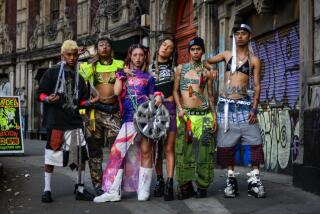SURF COUNTY, USA : Fashion Starts on the Beach for Surf Wear Industry
- Share via
“This is our customer, right here,” says David Miller, president of Off Shore of California, nodding toward the small group of surfers hunkered down in beach chairs at Laguna’s Main Beach. “You have to come out and look at the 16-year-olds.”
Miller, the new president of Off Shore in Anaheim, says the $1-billion active wear industry rides largely on fashion tides governed by teen-agers worldwide, and one way to know the waters is to spend time at the beach.
Relaxing in the shade of a tree in slacks and an open-necked white shirt, Miller himself would not be mistaken for a sand rat, but it is clear that he enjoys his business. The occasion is an Off Shore focus group, a low-key meeting of the company’s management and design staff with members of its company-sponsored surf team. Various members of the team are invited to participate in a focus group about every two months.
Quiksilver, Billabong, Ocean Pacific Sunwear, and Maui and Sons, all major, Orange County-based surf wear labels, also keep their eyes on the beach--by supplying amateur and professional surfers with the firms’ latest gear and getting feedback from the surfers as to how the clothes fit and wear and what the surfers’ friends are saying about them.
“We all spend a lot of time on the beach,” says Tom Hancock, national sales manager at Maui and Sons in Costa Mesa, which sponsors a number of amateur and professional surf teams. “It’s a very open atmosphere as to what the next product should be.”
Gemma Turi, Off Shore’s vice president of marketing, says: “We always hold (focus groups) at the beach, where the young surfers are more comfortable and more willing to talk. It’s just deadly when you take them into the office.”
Off Shore’s Miller asks the four surfers invited to this particular focus group whether they like the Lycra trunks they’ve been wearing in the water. The young men laugh self-consciously. Lycra is a stretch fabric, so that the trunks, unlike traditional board shorts made of cotton or other fabrics, are skin tight, making the surfers embarrassed to leave the water.
The group discusses the possibility of making trunks with neoprene--a thick but lightweight synthetic rubber--along with the Lycra. Judiciously placing the neoprene would solve the overexposure problem, they say. The drawback, Miller points out, is that the retail price of such shorts would be between $55 and $65.
Brian Alper, a 15-year-old from Huntington Beach with a Tom Cruise grin, suggests Lycra trunks with a flap that would drop down over the front. A good place for a logo, someone else suggests.
Miller asks about specific colors. A wet suit in the right colors will attract a lot of attention and do wonders for the surfer’s visibility. “You (can) have a dorky guy making a dorky move, but he looks great,” surfer Doug Bury of Laguna Beach points out.
Jean Butler, vice president of merchandising for Off Shore, pulls samples of some around-town attire from a bulging gym bag. Stone-washed denim in dark, muted colors earns the surfers’ approval, and a knit fabric goes over well, but a madras-like cloth makes Miller nervous about its ‘60s overtones, although he notes it’s big in the southeastern states.
The meeting largely confirmed his ideas, Miller says, but he did pick up a few tidbits.
Maui and Sons’ day-to-day point man at the beach is Darren Brilhart, 25, who serves as the manager of the company-sponsored surf team. “I don’t make a lot of money, but the lifestyle’s great,” Brilhart says of the job.
Maui and Sons tries out its new styles on amateur and professional surfers, supplying them with trunks, shirts, pants and other sportswear.
For surfers, the connection with an active-wear manufacturer offers a modest income, a wardrobe, recognition in the sport and attention from peers. For the company, besides the feedback, it offers an important route to brand visibility. It doesn’t hurt to have local heroes wearing your particular brand around town. Most local manufacturers sponsor individual surfers on both coasts and in Hawaii, and sometimes in Australia. “A lot of kids around here are sponsored,” Miller says.
People at the beach react when Todd Miller, 21, shows up in his latest Quiksilver-issue clothes. He hears, “That’s killer. Where’d you get that?”
Grant Collins, 17, of Newport Beach, a member of the Maui and Sons surf team, says, “If you’re out here (54th Street in Newport Beach) every day with a logo on your board, people know you’ve got the new clothes.”
While company sponsorship provides just enough renumeration for many of the kids to be full-time beach dwellers, they understand their corporate responsibilities. “You have to work for it,” Collins says. “You have to do good for the company, or they shut off the clothes. It’s like you’re a walking billboard.”
That can be a competitive sport, too. Darren Brilhart’s roommate is Todd Miller, who surfs for rival Quicksilver. “Todd and I compete at everything we do,” Brilhart says.
Quiksilver is more focused on “hard-core surf wear,” the two agree, although Brilhart says Maui recently came out with Full Circle, a line for serious surfing. Of Maui’s since-restyled dress-clothes line, Brilhart notes: “Last year we got too much into the mall scene. Really fluorescent colors. The team said it was too hokey.”
The intense interest in active wear among teen-agers and young adults is exactly what Off Shore and other active-wear companies are counting on. Off Shore is already a $20-million company, and David Miller says he has been given the go-ahead by parent Merrill Lynch to take the company to the next plateau. “We want to be very fashion-forward--willing to take a chance on something new,” Miller says.
To accomplish this, “we visit specialty stores, surf shops and department stores,” Off Shore’s Gemma Turi says. “You have to travel constantly and listen.”






